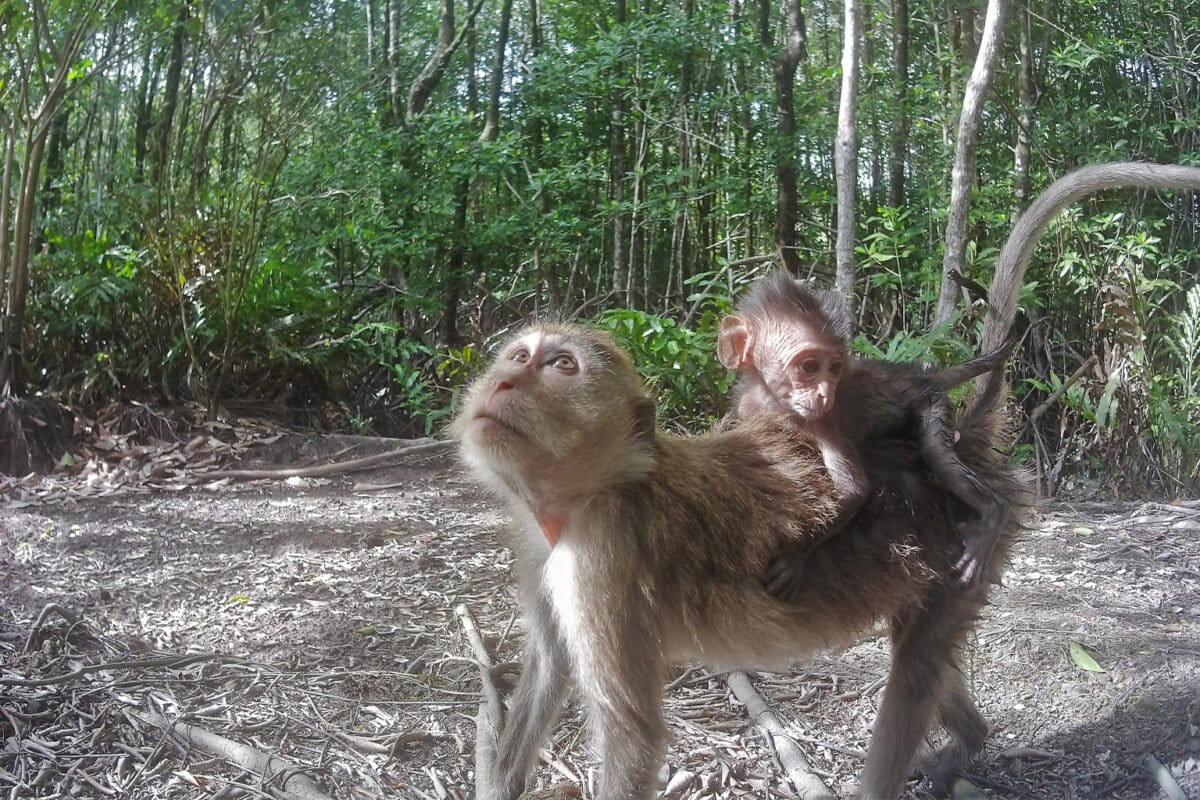Conservation authority the IUCN has upheld the endangered status of the long-tailed macaque after rejecting the U.S. biomedical lobby’s challenge to downgrade it.Demand from research labs has fueled illegal “monkey laundering,” with wild-caught macaques funneled through breeding farms in Cambodia, Laos and Vietnam and exported as captive-bred animals.U.S. industry lobbyists have opposed stronger protections to maintain access to macaques for biomedical testing, despite evidence of the widespread illegal trade.Conservationists warn that poaching, the pet trade and online abuse continue to endanger the species, and call for tougher laws and greater accountability.
See All Key Ideas
BANGKOK — The long-tailed macaque will remain on the Red List of the IUCN, the global wildlife conservation authority, despite objections from the biomedical industry arguing the designation hampers research that relies on the primate to test vaccines and drugs.
The IUCN escalated the conservation status of the species, Macaca fascicularis, from vulnerable to endangered in 2022 after macaques poached from the wild were found to have been laundered into breeding farms in Cambodia, Laos and Vietnam supplying laboratories abroad. The National Association for Biomedical Research (NABR), a U.S. lobby group, challenged the listing, but the latest assessment, published Oct. 10, found that wild populations of the macaque had declined by 50-70% over the past three decades. That led the IUCN to reaffirm the species’ endangered listing.
“I’m happy to see science prevail, but I’m not happy to see the long-tailed macaques endangered,” Malene Friis Hansen, co-author of the assessment and a leading researcher on the species at Aarhus University in Denmark, told Mongabay by phone.
“This is a species of primate that shouldn’t be in this situation — that we’ve pushed such an adaptive synanthrope to this stage should be an eye-opener.”
The NABR filed its complaint in 2023, alleging conflicts of interest and scientific errors had influenced the original endangered listing. But last week, the IUCN announced an internal investigation had found no breach of its conflict-of-interest policy. While the IUCN acknowledged that the original assessment contained some “emotive, value-laden language,” it deemed this had no impact on the listing.
“In terms of who would benefit from downgrading long-tailed macaques [back] to vulnerable status, it really depends on who acts according to the IUCN Red List’s listings or not,” Hansen told Mongabay, noting that Southeast Asian governments are failing to protect the species in line with their endangered status. “In the past five years, there’s been a great increase in price for long-tailed macaques to be used in biomedical research and this seems to have driven illegal activities.”
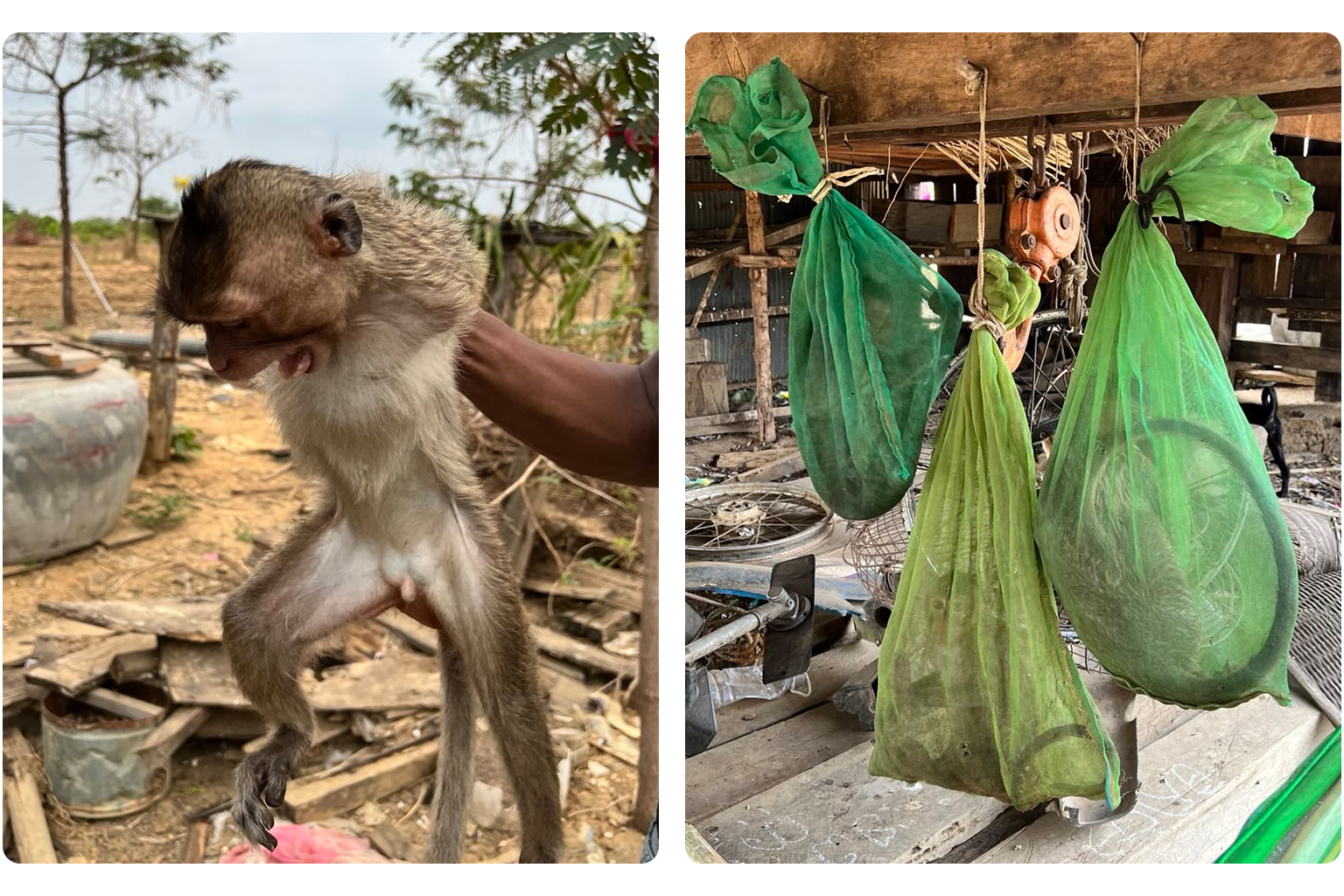 Monkey poaching has reportedly declined in Cambodia as the populations and habitats of long-tailed macaques are believed to have declined in recent years. Images supplied by source.
Monkey poaching has reportedly declined in Cambodia as the populations and habitats of long-tailed macaques are believed to have declined in recent years. Images supplied by source.
‘Monkey laundering’
The COVID-19 pandemic catalyzed demand for long-tailed macaques as companies raced to develop vaccines. In early 2020, China, long the world’s leading supplier of monkeys for research, banned exports of the species, causing a shortage in countries like the U.S.
Cambodia then saw a 99% jump in exports of long-tailed macaques from 2019 to 2020, according to CITES trade data, filling the gap left by China. Numerous reports suggested that the Cambodian supply of captive-bred macaques was nowhere near the volume of exports, prompting suspicions that wild populations were being illegally exploited to make up the shortfall — something the Cambodian government has largely denied.
Mongabay previously reported that Cambodian poachers were making up to $200 per wild monkey sold to breeding farms, while shipping records show breeding farms sell macaques to biomedical companies for tens of thousands of dollars per head, making “monkey laundering” a lucrative business.
In 2022, U.S. federal prosecutors said they had evidence of Cambodian government complicity in the poaching, laundering and sale of long-tailed macaques to U.S. companies. Evidence emerged showing senior officials from Cambodia’s Department of Forestry encouraging monkey smuggling within supposed captive-breeding facilities.
One of the Cambodian officials, Kry Masphal, eventually stood trial in the U.S. after more than a year of house arrest. Masphal was acquitted after a five-year investigation by the U.S. Fish and Wildlife Service essentially failed to quell the illicit trade of monkeys that’s driving the species into decline. No officials have been held accountable for monkey smuggling under Cambodian law.
 Screenshot from undercover footage acquired by the U.S. Fish and Wildlife Service during their five-year investigation into Cambodian monkey farms.
Screenshot from undercover footage acquired by the U.S. Fish and Wildlife Service during their five-year investigation into Cambodian monkey farms.
Masphal’s trial and other reports detailing the scheme did prompt a review of Cambodia’s long-tailed macaque exports by CITES, the international regulator of trade in endangered species. Ultimately, however, a proposal to suspend Cambodia’s macaque exports was blocked, largely by CITES member states that buy monkeys from Cambodia for biomedical research. It’s estimated that at the time of Masphal’s arrest, Cambodian long-tailed macaques made up 60% of the estimated 30,000 primates imported each year by the U.S. biomedical industry for research and testing. As such, the industry has been eager to retain access to the Cambodian supply.
Given that the IUCN only considers wild populations when assessing a species’ conservation status, Hansen raised the question: “If these companies claim they’re only using captive-bred monkeys and not wild-caught ones, then why are they so concerned about the IUCN listing?”
The NABR, which represents many of the largest U.S. biomedical research companies involved in the trade of long-tailed macaques, didn’t respond to an emailed request for comment.
While declining to answer specific questions, on Oct. 14 the NABR issued a press release condemning the IUCN’s decision to uphold the endangered status of long-tailed macaques and further alleging that a conflict of interest may exist regarding the authors of the 2025 assessment. The NABR’s press release didn’t detail what the alleged conflicts of interest may entail, but Matthew Bailey, president of the NABR, was quoted as saying the lobby group was “disappointed.”
“It is beyond comprehension that the IUCN claims the species is at risk while simultaneously claiming it is one of the world’s most invasive species,” Bailey was quoted as saying in the press release. “NABR will continue to educate policy makers and the public on these issues to protect public health and the integrity of the scientific process.”
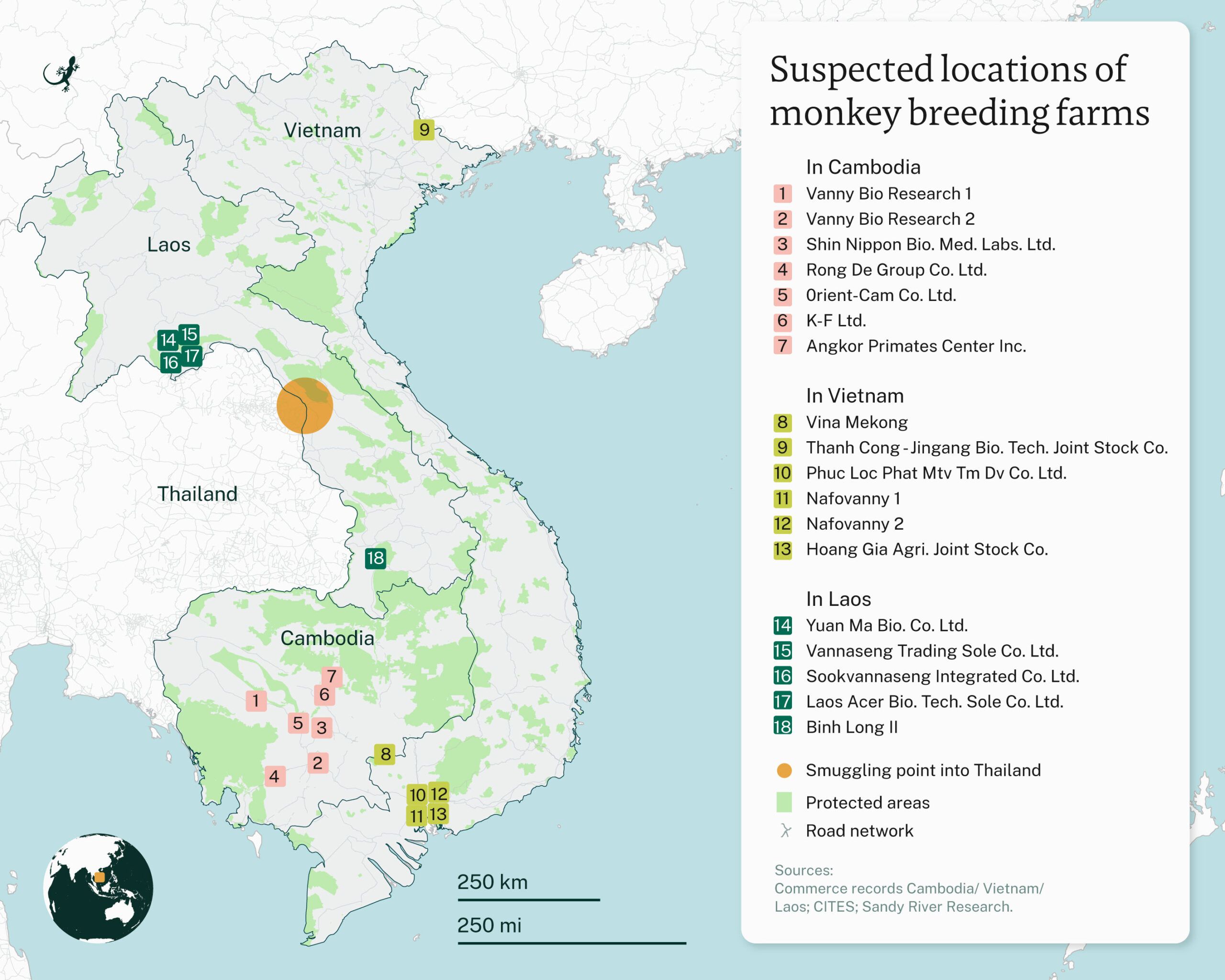 Using publicly available data, Mongabay was able to map out many of the suspected long-tailed macaque farms across Cambodia, Laos and Vietnam, as well as an established smuggling point in Thailand. Image by Andrés Alegría / Mongabay.
Using publicly available data, Mongabay was able to map out many of the suspected long-tailed macaque farms across Cambodia, Laos and Vietnam, as well as an established smuggling point in Thailand. Image by Andrés Alegría / Mongabay.
Delinquent platforms and smear campaigns
It’s not just biomedical research demand that’s pushing long-tailed macaques to the brink of extinction.
Poaching for the exotic pet trade and the disturbing online world of animal abuse videos — which range from costume-clad monkeys performing stunts for entertainment to the outright torture, mutilation and killing of the animals — has become more widespread. Indonesia in particular appears to be a hub for the production of such videos, but the audience is global, thanks to weak moderation by social media platforms.
Hansen said governments need to do more to protect the species domestically, using the IUCN listing as an impetus to ensure no individuals are taken from the wild for biomedical or toxicological research or to replenish captive populations in breeding centers.
She added that social media giants like Facebook, TikTok, Instagram and YouTube need to be held legally accountable for animal abuse content posted to their platforms. Calls are growing for platforms and users found to be participating in or profiting from the exploitation of animals online to face harsher consequences.
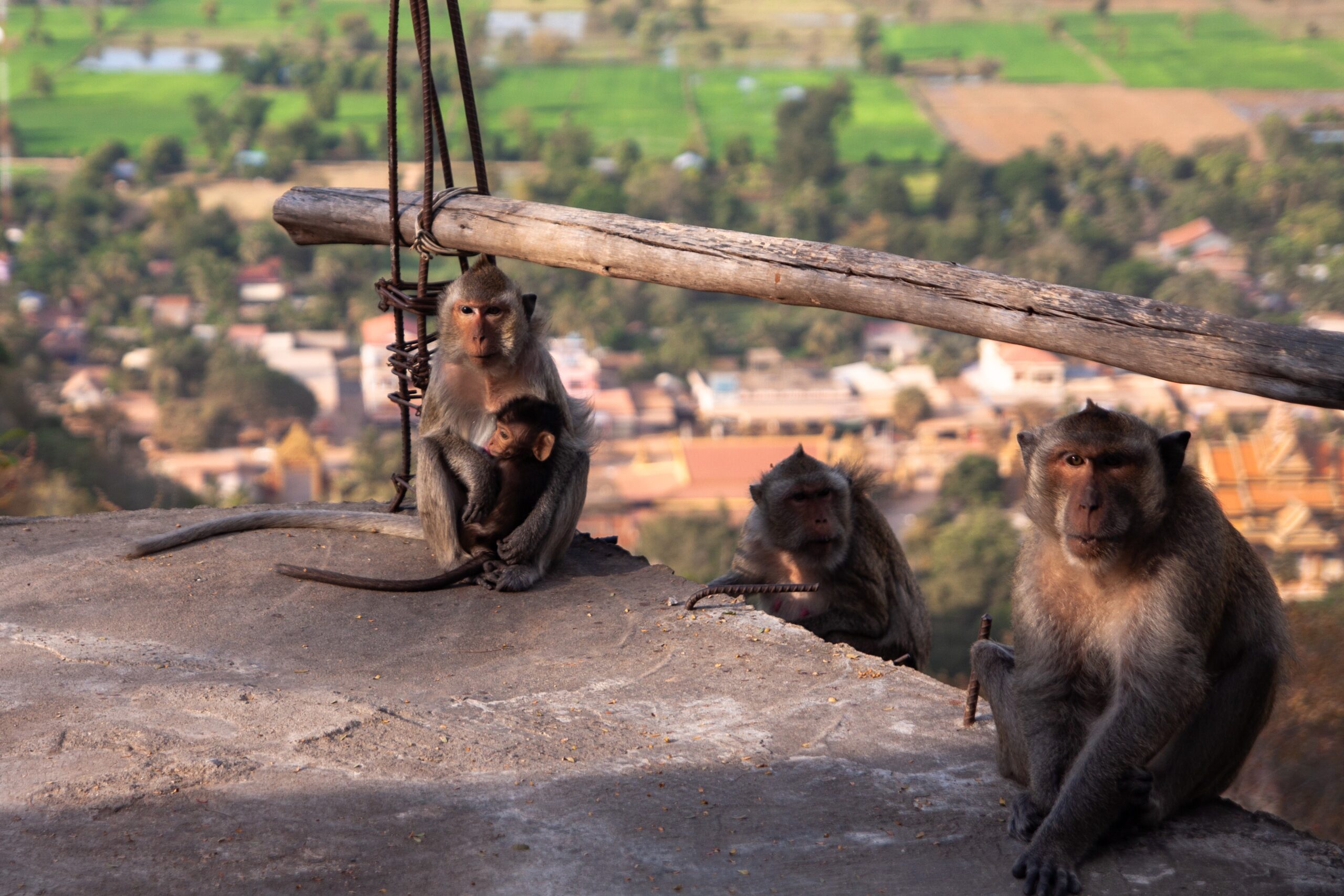 Long-tailed macaques living in the mountains of Cambodia’s Battambang province. Photo by Gerald Flynn / Mongabay.
Long-tailed macaques living in the mountains of Cambodia’s Battambang province. Photo by Gerald Flynn / Mongabay.
“Of course, habitat protection is needed too,” Hansen said. “But again, with the long-tailed macaque, human settlements are part of its habitat; if we could in some ways acknowledge that, or find some form of coexistence, then that would also help the species.”
Long-tailed macaques are often regarded as ubiquitous, particularly at popular Southeast Asian tourism sites like Angkor Wat in Cambodia or Lopburi city in Thailand, giving the impression that they’re pests that exist in abundance. But it was the destruction of their natural habitats that pushed the species into urban environments in the first place. And while they may be seen in large numbers by tourists, they’re increasingly difficult to find in the jungles where they belong.
Across Cambodia, Indonesia, Malaysia and Thailand, efforts are being made to curb their populations in urban areas and tourism sites. Yet at the same time, the rate of deforestation throughout the region continues to push the monkeys into contact with humans.
“Local smear campaigns against the species don’t help,” Hansen said. “There’s been a lot of public pressure — and a lot of money to be made — in shaping our perception of this highly intelligent species.”
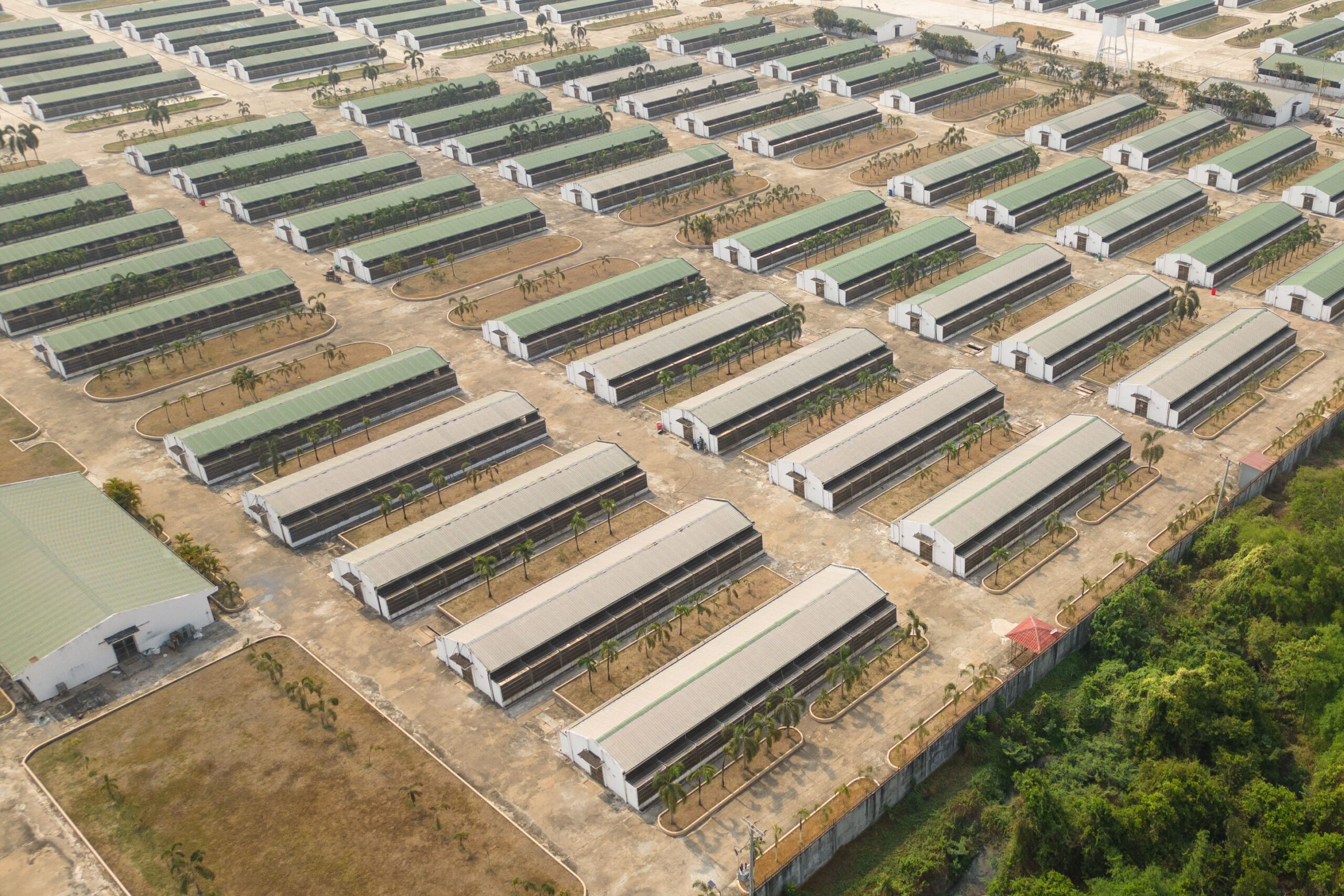 Reporters visited a long-tailed macaque breeding facility in Pursat province. The farm is owned by Vanny Bio, one of the companies indicted by U.S. federal prosecutors. Image by Gerald Flynn / Mongabay.
Reporters visited a long-tailed macaque breeding facility in Pursat province. The farm is owned by Vanny Bio, one of the companies indicted by U.S. federal prosecutors. Image by Gerald Flynn / Mongabay.
The monkey trade goes on
Such pressure appears to have been successful in the U.S., where lobbying efforts are widely regarded as behind the U.S Fish and Wildlife Service’s decision not to extend protection to long-tailed macaques under the Endangered Species Act. That’s despite a 2023 petition from People for the Ethical Treatment of Animals (PETA) requesting the macaque be protected under the U.S. law so as to align domestic legislation with IUCN guidelines.
The NABR praised USFWS’s decision, saying at the time that it looked forward to working with the agency “to ensure the integrity of its scientific processes.”
It’s difficult to gauge the level of influence that the NABR has over U.S. legislators, but the body has long proven itself effective at ensuring the free flow of trade in long-tailed macaques. The NABR was the only observer party given time to speak at the CITES conference where the regulatory body declined to suspend Cambodian exports.
Despite the NABR’s nonprofit status, its senior executives are deeply involved in the biomedical industry, with board member Kevin McNelly currently working as vice president for global procurement of Charles River Laboratories — a company known to purchase long-tailed macaques from Cambodia and Vietnam. Charles River Laboratories was subpoenaed by the U.S. Department of Justice in 2023 in relation to its sourcing of macaques.
Also on the NABR board is John Sagartz, chief strategy officer at pharmaceutical company Inotiv, which also sourced monkeys from Cambodia and was subsequently investigated by the U.S. Securities and Exchange Commission for possible violations of the Foreign Corrupt Practices Act. That investigation was closed in June, however, with no enforcement action taken.
“The IUCN’s confirmation that long-tailed macaques are endangered is grounded in science and evidence, and it exposes how industry lobbyists weaponized a false conflict of interest claim to delay protections and keep the illegal primate trade alive,” Lisa Jones-Engel, a primatologist working with PETA, told Mongabay in a message.
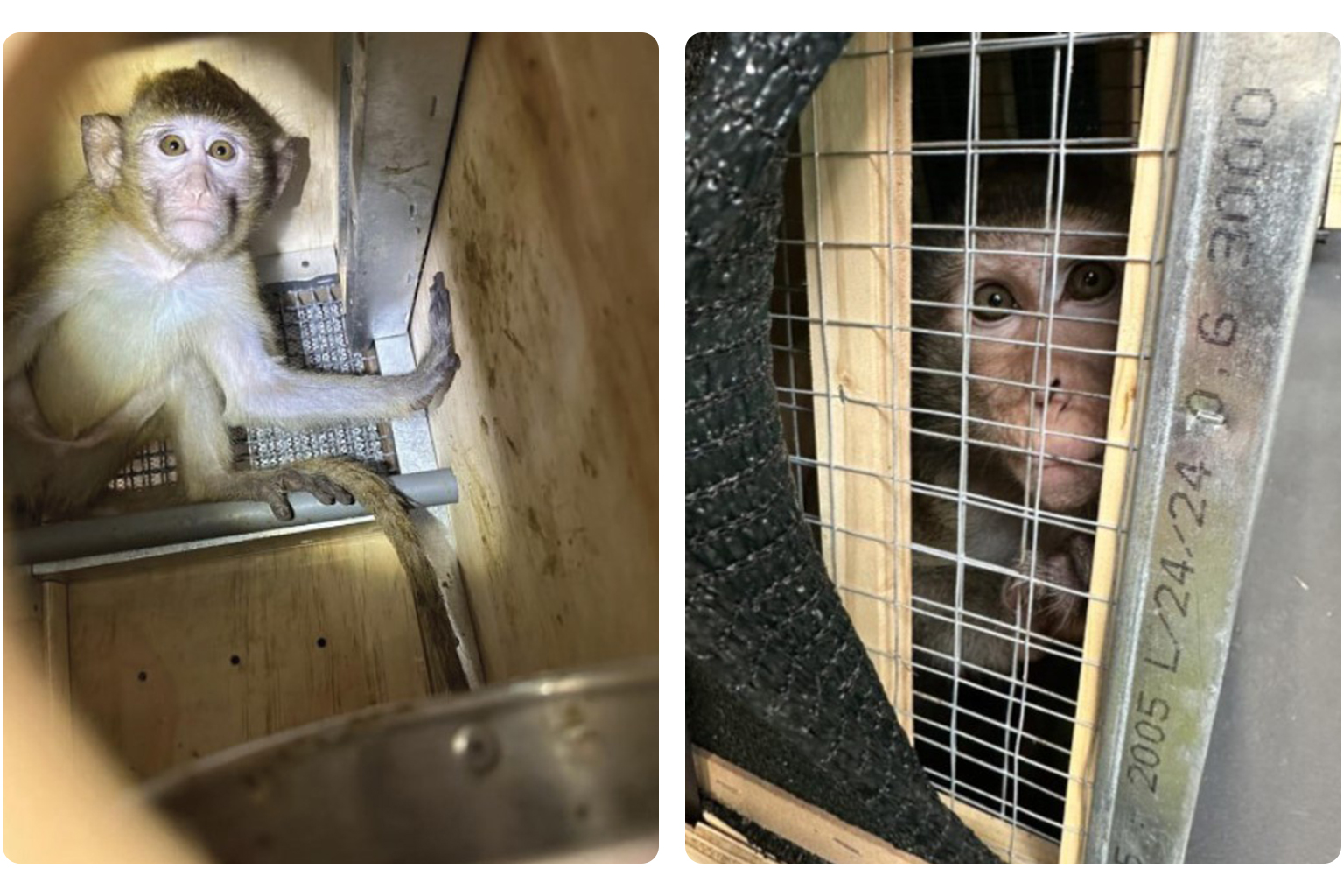 Inspections at Brussels Airport found long-tailed macaques exported from Vietnam. Image supplied by Animal Rights BE.
Inspections at Brussels Airport found long-tailed macaques exported from Vietnam. Image supplied by Animal Rights BE.
After the rejection of its petition, PETA filed another in January 2025 to have long-tailed macaques protected under the Endangered Species Act. In the absence of formal action on its petition, the animal rights NGO on Oct. 10 published a letter addressed to the U.S. Fish and Wildlife Service reiterating the need for protection of the long-tailed macaque.
Far from simply relying on the science, PETA’s letter questions the seemingly close relationship between regulators in the U.S. and business interests that operate in Cambodia. The letter pointed to photos posted online in March 2025 by Cambodia’s Ministry of Agriculture, Forestry and Fisheries showing former U.S. interior secretary David Bernhardt — who oversaw USFWS during its five-year investigation in Cambodia — visiting Vanny Bio Research, K-F Cambodia and Orient Cam, three breeding facilities accused of monkey laundering.
Bernhardt’s visit appeared to coincide with the presence of Hing Ip Chung, the general manager of Vanny Bio Research, who is currently wanted by the U.S. Department of Justice, as well as that of a Charles River Laboratories representative, raising questions about the efficacy of law enforcement operations.
Even though Masphal, the Cambodian forestry official who stood trial in the US, managed to walk free, PETA pointed to evidence suggesting the smuggling of wild-caught monkeys in Cambodia continues unabated.
“While the [USFWS] drags its feet, the monkey laundering carries on,” PETA wrote in its letter last week. “As recently as last month, a whistleblower relayed to PETA that hundreds of [long-tailed macaques] died while en route to K-F Cambodia when the trucks transporting them broke down. This farm is on record with CITES as only engaging in captive breeding, which begs the questions: Why would K-F Cambodia be bringing in several hundred [long-tailed macaques], and where were these monkeys sourced from?”
Khim Finan, a spokesperson for the Cambodian Ministry of Agriculture, Forestry and Fisheries, did not respond to questions sent by Mongabay regarding the allegations of ongoing monkey laundering, the ministry’s relationship with private sector actors it’s supposed to regulate, or whether the ministry has complied with CITES’s requests for more data regarding the abnormally high birth rate ahead of the CITES summit scheduled for Nov. 24 to Dec. 5, 2025, in Uzbekistan.
Banner image: Long-tailed macaques were originally listed as endangered on the IUCN’s Red List in 2022 due to overexploitation and habitat loss.

